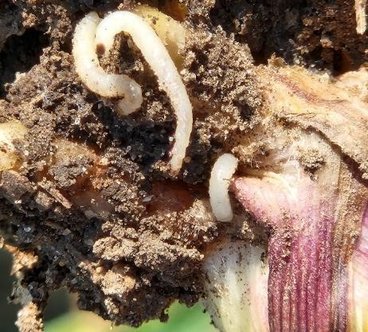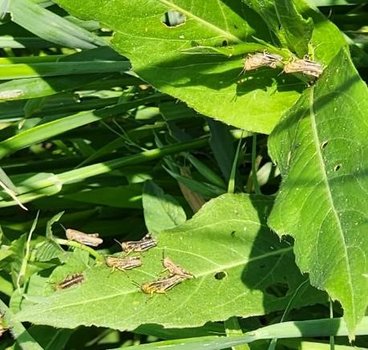Corn

Corn rootworm larvae (Figure 1) and root injury are visible now. Feeding is ongoing and root injury is still increasing, but you might be able to float some larvae to see their stage of development.
If the rootworms cooperate and create enough devastation at the UMN Southwest Research and Outreach, we will schedule a field day.
If you scout for European corn borer and find a field that has egg masses or larvae, please let me know. Dr. Fei Yang is now on board as the UMN corn extension entomologist. He is looking to collect larvae for a study on Bt resistance.
Soybeans
If you come across scattered pockets of plants with soybean aphids while scouting for weeds or just feeling a little cranky, try to resist the urge to add a “just in case” insecticide to an herbicide application.
At least a portion of the soybean aphid population is resistant to pyrethroid insecticides. Insurance insecticide applications can worsen aphid problems by poor control of aphids and good control of beneficial insects. High temps and moisture stress will favor two-spotted spider mites, especially as soybeans enter the reproductive phase. Depending on the pyrethroid used, you can flare spider mite populations or use up one of your options for treating an economically threatening mite infestation.
I have received a couple of reports of large aster leafhoppers populations in soybeans planted into a rye cover crop. Immigrating leafhoppers colonized the rye, moving to soybeans when the rye was terminated. I suspect winged adults will leave the field, but the field might be worth watching. The aster leafhopper transmits the aster yellows phytoplasma. Soybeans are not particularly susceptible, but I did find references to the possibilities of aster yellows in soybeans.
D. Mollov, M. I. Chilvers, and J. L. Jacobs. 2014. First Report of Aster Yellows Phytoplasma in Soybean in Michigan Plant Disease 98:11, 1578-1578
M.E. Lee, C.R. Grau, L.A. Lukaesko & I.-M. Lee (2002) Identification of aster yellows phytoplasmas in
soybean in Wisconsin based on RFLP analysis of PCR-amplified products (16S rDNAs), Canadian
Journal of Plant Pathology, 24:2, 125-130, DOI: 10.1080/07060660309506986
I received reports, but no images of numerous small caterpillars in soybeans. None of these have been economic and the most likely candidates are loopers or green clover worms. I have not seen a specimen or photo but will try to get this sorted out.
IDC symptoms are unusually prevalent in some areas this year. Could be related to weather, variety, SCN, disease, or any combination of the above.
Alfalfa
Potato leafhoppers are at economic threshold levels in some alfalfa at the SWROC.

Grasshoppers
Eggs continue to hatch in alfalfa, field borders, and roadsides. Grasshoppers prefer untilled, bare soil to lay eggs in late summer and populations are favored by dry years. There are some very high nymph populations in areas of SW that have been dry the last few years.
Mowing can encourage the movement from production areas into crops. At this time, nymphs are still small and easy to control with insecticide if warranted.
In soybeans, grasshopper defoliation can be combined with that caused by other insects/causes.
To scout for grasshoppers, walk a series of straight lines either through fields or along field margins. Grasshopper action thresholds are calculated as grasshopper numbers/yd 2. As you walk, look ahead and isolate a 1ft 2 area. As you approach, count the grasshoppers you see move in it. Observe at least 20 of these 1ft 2 sample areas. Calculate the average number of grasshoppers in these squares (total no. of grasshoppers counted in all squares/number of squares) and multiply this average by 9 to get the average number of grasshoppers/yd 2. For nymphs, the threshold is 50-75/yd2 in the field margin or 30-45/yd2 in the field. Border treatments can be effective if timed correctly.
Butterflies
You may have noticed many moderate-sized, very active, tan butterflies recently. Hackberry emperor butterflies are not pests and are associated with hackberry trees.
Orange sulfurs are the smaller, yellow butterflies that are also abundant now. The larvae are the alfalfa caterpillar. Yield-threatening populations on alfalfa and soybeans are rare but they can add to the feeding injury from other defoliators.
Happy trails,
Bruce
